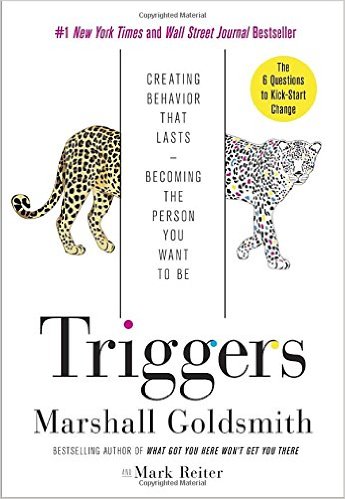Triggers
Goldsmith, Marshall. (2015). Triggers. New York: Crown
If you haven’t read What Got You Here Won’t Get You There: How Successful People Become Even More Successful (2007) and Mojo: How to Get it, How to Keep It, How to Get It Back If You Lose It (2010) by Marshall Goldsmith, we highly recommend both. The first book focuses on taking your skill level and extending it. The second book is about keeping the spirit and engagement alive in your work.
For those who are interested in continuing to develop your coaching skills, Triggers is the book for you. Having been to his Stakeholder Coaching Institutes, I can tell you that Dr. Goldsmith is incredibly sincere about helping others grow.
He starts with two truths. This is NOT the game of two truths and one lie. First, change for human beings is hard, and second, no one can make us change. Most of us underestimate what is takes to change, and especially a behavior that might have had success in the past.
Goldsmith outlines fifteen triggers that get in our way of accomplishing sustainable change. Those of us who have coached others for a while know these triggers too well. ***Excuses abound.
One of the tenets of his work is, what are triggers according to Dr. Goldsmith? What are the triggers that keep us from changing and responding — doing the same thing over and over again even if it doesn’t work. Triggers set off our automatic response system. In education sometimes power and authority trumps good thinking. Remember, Einstein said you can’t solve the problem with the same kind of thinking that created the problem. Be aware of personal triggers that divert your thinking and behavior.
So, what are your triggers that send you in to an automatic response process? Is that making the problem better or worse? Are you getting the results you want or not? Triggers can come from our background and experiences. They can come from internal thought processes or external events. What we have learned in about 100 years of education is: Bottom line, if it isn’t working, try something else.
Chapter 6 talks about how we are excellent planners and not so good doers. This reminds me of Pfeffer and Sutton’s work, The Knowing-Doing Gap. Talk substitutes for action.
One of our favorite quotes in the book is from Mike Tyson, “Everyone has a plan until they get punched in the face.” Ah, theory meets reality! John Dewey said years ago we need theory and practice. That is still true today.
The final concept to mention is “Active Questions.” This was a huge wake up call for us. Lots of us are elegant question askers. Here is a question, “does your questions lead to action?” Yikes! To quote Marshall Goldsmith, “people don’t get better without follow up.”
Here are the examples used in the book of the difference between passive and active questions.
Passive questions:
- How happy were you today?
- How meaningful was your day?
- How positive were your relationships with people?
- How engaged were you?
Active questions:
- Did you do your best to be happy?
- Did you do your best to find meaning?
- Did you do your best to build positive relationships with people?
- Did you do your best to be fully engaged?
Yes, these questions can be answered yes or no. The follow up questions about what did you do that indicates you did your best today can be very enlightening.
There is much more in this newest book that will people learn, grow, and coach more effectively. We highly recommend it for personal and/or professional use.

